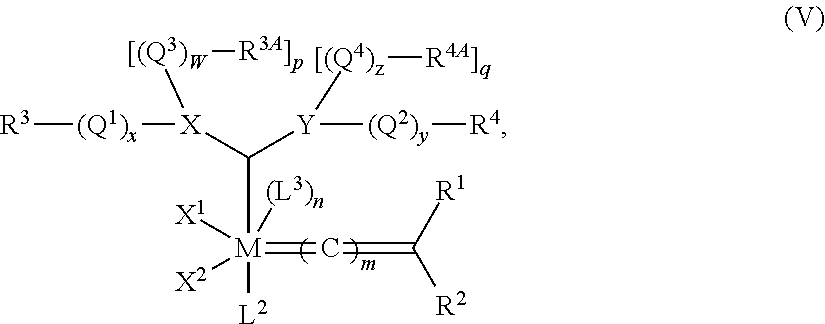Thermal methods for treating a metathesis feedstock
- Summary
- Abstract
- Description
- Claims
- Application Information
AI Technical Summary
Benefits of technology
Problems solved by technology
Method used
Image
Examples
example 1
[0161]In this example, the feedstock was heated to 200° C. to degrade and diminish catalyst poisons from the feedstock. The thermal treatment procedure began by filling a 1 liter bottom sample port reactor with 400 g feedstock of Cognis Undistilled Canola Fatty Acid Methyl Ester (FAME), MF-CNF6C02. The feedstock was then stirred in the reactor with an agitator. A vacuum was pulled on the flask to degas, followed by a nitrogen sparge. Slowly, the feedstock was heated while maintaining the best vacuum possible. Samples were taken when the feedstock reached 45, 75, 150, and 200° C. to analyze for peroxide value (PV). The feedstock was then held at 200° C. Samples and tests for PV were run until PV was less than 0.5 meq / kg. Tests for PV were run using the American Oil Chemists Society (AOCS) Method Cd 8b-90. Subsequently, the feedstock was removed from its heating source, and was cooled with air and an ice bath. The nitrogen sparge was then stopped when the feedstock reached 40° C. The ...
example 2
[0169]In this example, a thermal treatment was combined with an adsorbent treatment to further increase catalyst activity or turnover. The treatment began by filling a 3-neck 500 mL round bottom flask with 300 g feedstock of Fatty Acid Methyl Ester (FAME). The feedstock was then stirred in the flask with a stir bar. A nitrogen sparge began as the feedstock is heated to 45° C. The feedstock was held at 45° C. for 45 minutes to degas. Slowly, the feedstock was heated to a target of 200° C. Samples were taken when the feedstock reached 45, 75, 150, and 200° C. to analyze for peroxide value (PV). The feedstock was then held at 200° C. Samples and tests for PV were run until PV was less than 0.5 meq / kg. Tests for PV were run using the American Oil Chemists Society (AOCS) Method Cd 8b-90.
[0170]Subsequently, 2.5 wt % magnesium silicate (Magnesol) and 1.25 wt % Celite were added to the flask. The feedstock was cooled to 80° C., and then held at 80° C. for 1 hour to allow the magnesium silic...
example 3
[0175]In this example, the feedstock was treated by an adsorbent only to demonstrate that additional non-peroxide catalyst poisons are present in natural oil feedstocks in addition to peroxides. The feedstock (FAME) was treated with either bleaching clay or magnesium silicate (Magnesol). The results are shown in Table 3.
TABLE 3metathesisPVstartingcatalyst 827valuetype ofmaterial(ppm / (meq / GC %Exp #FAMEtreatmentdb)kg)conversion109-014E2Soy2.5 wt. %30.328bleaching clay109-006F1Soy1 wt. %33.845Magnesol109-014B2Canola2.5 wt. %40.78bleaching clay109-006B1Canola2.5 wt. %42.236Magnesol
[0176]As shown in Table 3, when the canola and soybean feedstocks are treated with 2.5 wt % bleaching clay, both feedstocks have peroxide values of less than 1 meq / kg, but the product conversions are 8% and 28% (or 11% and 40% conversion of the maximum theoretical limit, assuming a limit of 70%) for canola and soybean oil feedstocks, respectively. Instead, when soybean oil is treated with 1 wt % magnesium sili...
PUM
 Login to View More
Login to View More Abstract
Description
Claims
Application Information
 Login to View More
Login to View More - R&D
- Intellectual Property
- Life Sciences
- Materials
- Tech Scout
- Unparalleled Data Quality
- Higher Quality Content
- 60% Fewer Hallucinations
Browse by: Latest US Patents, China's latest patents, Technical Efficacy Thesaurus, Application Domain, Technology Topic, Popular Technical Reports.
© 2025 PatSnap. All rights reserved.Legal|Privacy policy|Modern Slavery Act Transparency Statement|Sitemap|About US| Contact US: help@patsnap.com



